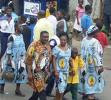
Along the pilgrim road to Santiago de Compostella, images of Santiago (Saint James)are seen everywhere. The two most common ones are of "Saint James the Pilgrim" and "Saint James the Moor Slayer". Often, the two images are even seen side-by-side, like at the entrance to a church. To me, it is a symbol of how people of faith can take something as sacred as pilgrimage and turn it into something as profane as a crusade. I thought about this when I was asked to write an article for a local newspaper in response to the question: "What does your faith tradition teach you about interfaith relations?" At our best, we are Saint James the Pilgrim and at our worst we are Saint James the Moor Slayer. It is sad to acknowledge that the two often exist side-by-side within us and within our religious communities, like those two images above the same church door. However, whenever Saint James the Pilgrim emerges to the forefront I am given profound hope. I guess this is another way of saying what I wrote in the article for the newspaper. Here is what I submitted:
When we are at our best, Christians follow Christ’s example of radical inclusiveness and unconditional love and grace for all people. At our best, we remember his loving way of interacting with people of other cultures and other faith traditions and we seek to do the same. At our best, we live in the promise that God desires all people to be saved and we let that shape our lives in profound ways. At our best, we follow our baptismal calling to work for justice and peace in all the earth. When we are at our worst, Christians turn Christ’s inclusive promises into exclusive claims about who will be saved and who will be condemned. At our worst, we use select passages from the story of a non-violent Messiah to justify our own violence and our own addiction to retributive justice. At our worst, we even take the cross, a symbol of the world’s violence toward God, and we carry into battle as a sign of triumph over our enemies.
When we are at our best, Lutheran Christians put the Gospel of grace alone above everything else. At our best, we join Martin Luther in challenging every system of hierarchy and privilege that places some people above others while assuming its own special favor with God. At our best, we are leaders in the movement toward interfaith dialog and understanding that is gaining momentum in many parts of the world today. When we are at our worst, Lutheran Christians succumb to the same human frailties that burdened our leader. At our worst, we look like an aging Martin Luther who wrote the “Treatise Against the Jews” and who cringed at the thought of a Moslem presence in Western Europe. At our worst, we have taken these signs of human weakness and used them to justify our own xenophobia or our complacency when this finds expression in acts of hatred and violence.
A Lutheran way of understanding all of this is to say that we are, at the same time, saints and sinners. In other words, we are all, by nature, sinful and we are all, by God’s grace, made holy. In this abundant grace, we are also turned outward to the world around us. We are set free from the fear of judgment so that we can commit our whole lives to loving and serving our neighbor and to proclaiming this Gospel of grace in word and deed. Personally, I find this to be the most helpful and hopeful thing that we can bring to the question of “What does your faith tradition teach us about interfaith relations?” In every circumstance, it is a way of seeing that takes the focus off of who is in and who is out, or who is right and who is wrong. When Martin Luther died, some say that a piece of paper upon which he had scribbled his last words was pulled from his pocket. It simply said “We are all beggars, it is true.”







+of+IMG_0084.JPG)





